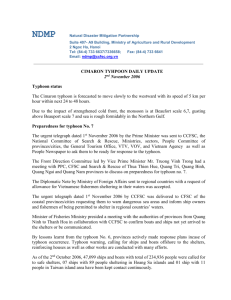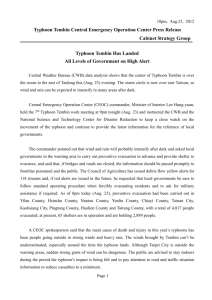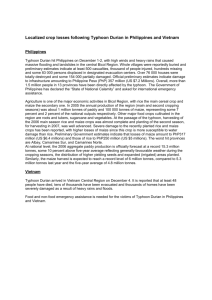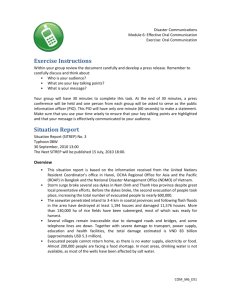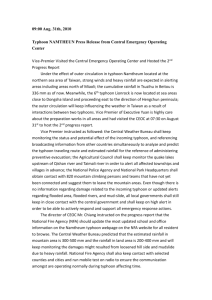advertisement
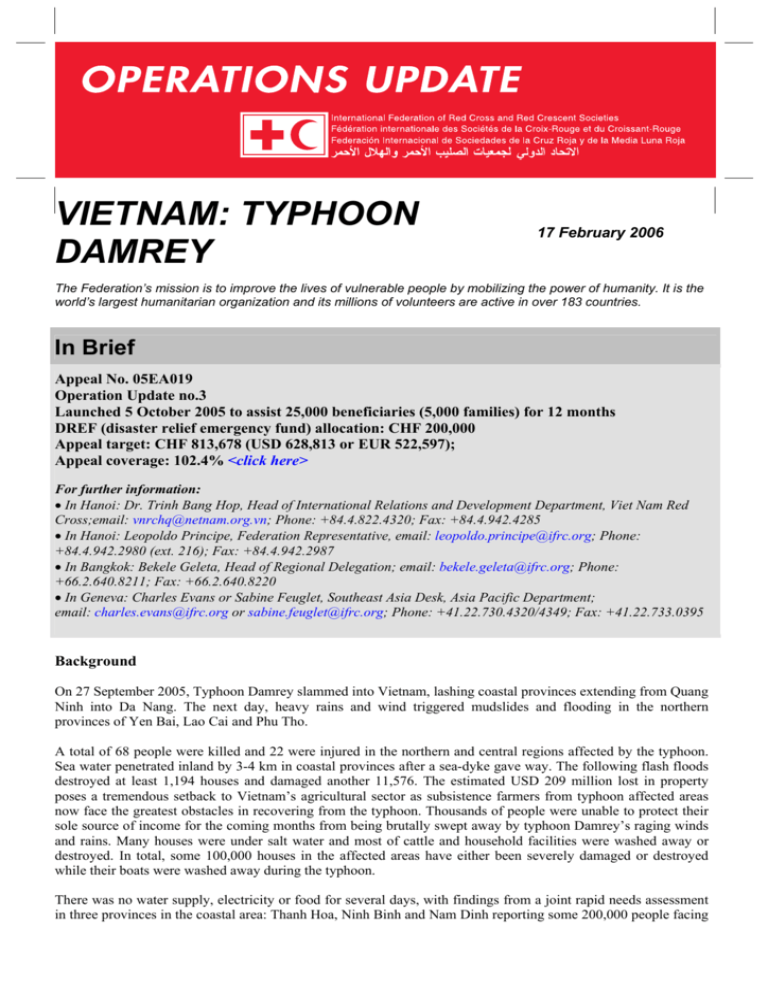
VIETNAM: TYPHOON DAMREY 17 February 2006 The Federation’s mission is to improve the lives of vulnerable people by mobilizing the power of humanity. It is the world’s largest humanitarian organization and its millions of volunteers are active in over 183 countries. In Brief Appeal No. 05EA019 Operation Update no.3 Launched 5 October 2005 to assist 25,000 beneficiaries (5,000 families) for 12 months DREF (disaster relief emergency fund) allocation: CHF 200,000 Appeal target: CHF 813,678 (USD 628,813 or EUR 522,597); Appeal coverage: 102.4% <click here> For further information: • In Hanoi: Dr. Trinh Bang Hop, Head of International Relations and Development Department, Viet Nam Red Cross;email: vnrchq@netnam.org.vn; Phone: +84.4.822.4320; Fax: +84.4.942.4285 • In Hanoi: Leopoldo Principe, Federation Representative, email: leopoldo.principe@ifrc.org; Phone: +84.4.942.2980 (ext. 216); Fax: +84.4.942.2987 • In Bangkok: Bekele Geleta, Head of Regional Delegation; email: bekele.geleta@ifrc.org; Phone: +66.2.640.8211; Fax: +66.2.640.8220 • In Geneva: Charles Evans or Sabine Feuglet, Southeast Asia Desk, Asia Pacific Department; email: charles.evans@ifrc.org or sabine.feuglet@ifrc.org; Phone: +41.22.730.4320/4349; Fax: +41.22.733.0395 Background On 27 September 2005, Typhoon Damrey slammed into Vietnam, lashing coastal provinces extending from Quang Ninh into Da Nang. The next day, heavy rains and wind triggered mudslides and flooding in the northern provinces of Yen Bai, Lao Cai and Phu Tho. A total of 68 people were killed and 22 were injured in the northern and central regions affected by the typhoon. Sea water penetrated inland by 3-4 km in coastal provinces after a sea-dyke gave way. The following flash floods destroyed at least 1,194 houses and damaged another 11,576. The estimated USD 209 million lost in property poses a tremendous setback to Vietnam’s agricultural sector as subsistence farmers from typhoon affected areas now face the greatest obstacles in recovering from the typhoon. Thousands of people were unable to protect their sole source of income for the coming months from being brutally swept away by typhoon Damrey’s raging winds and rains. Many houses were under salt water and most of cattle and household facilities were washed away or destroyed. In total, some 100,000 houses in the affected areas have either been severely damaged or destroyed while their boats were washed away during the typhoon. There was no water supply, electricity or food for several days, with findings from a joint rapid needs assessment in three provinces in the coastal area: Thanh Hoa, Ninh Binh and Nam Dinh reporting some 200,000 people facing Vietnam Typhoon Damrey 05EA019 operations update 3 2 food shortages. Of equal concern is the damage to wells caused by salt water which has made drinking water unavailable in most areas. The affected provinces are home to some 22 million people, including 11 indigenous minority groups, the majority of which live below the poverty level. Natural disasters pose a constant threat to the country’s work in reducing poverty. Although efforts are being made by the government and international organizations to introduce poverty reduction projects in these vulnerable areas, large-scale and sudden-onset natural disasters such as floods or typhoons can undermine any progress made through these projects. The Federation released CHF 200,000 from its Disaster Response Emergency Fund (DREF) to support the response of the Viet Nam Red Cross (VNRC) and on 5 October 2005, an emergency appeal was launched to support some 25,000 people for one year. Operational developments On 6 and 7 October 2005, seven days after typhoon Damrey ravaged Vietnam’s coast, thousands more people were forced to flee their homes as over 44,000 houses were submerged by dangerous floods in central Vietnam’s mountainous Quang Binh, Quang Tri and Thua Thien-Hue provinces. Rushing waters washed away 21,515 ha of rice and destroyed thousands more of hectares of vegetable farms, killing herds and destroying fishing ponds. Quang Tri was hardest hit by the eighth massive storm to strike the country this year, particularly in the province’s districts of Vinh Linh, Cam Lo and Gio Linh. In the storm’s aftermath, rural communities comprised of subsistence farmers are facing difficulty in obtaining food, and with many of the wells contaminated, they now lack access to water. Devastation: the typhoon ripped through several villages. On 2 November 2005, typhoon Kai-Tak struck Viet Nam, causing severe damage to the central provinces of Thua Thien Hue, Da Nang, Quang Nam and Quang Ngai, and also affecting Quang Binh and Quang Tri. Some of these provinces were already subjected to dangerous flooding less than a month previously – this latest battering claimed at least 19 lives, leaving 44 people injured and another 11 missing, according to the Central Committee for Flood and Storm Control (CCFSC). The typhoon also swept away over 9,000 houses, and flooded over 46,000 houses and 206 classrooms. Approximately 13,000 ha of rice and subsidiary crops and some 57 ships were inundated. Worse still, the catastrophe washed away a series of roads and irrigation works made up of more than 1.1 million cubic meters of land and stone. Total losses were initially estimated at some VND 180 billion (CHF 14,580,000). The VNRC at local level has been actively supporting the local authorities with evacuation and distribution of essential relief items to the needy. The national society headquarters has been monitoring and requesting situation updates from the affected provinces. Responding to the needs in Quang Binh, Quang Tri and Thua Thien-Hue provinces, the Vietnam Red Cross (VNRC) headquarters released 750 household kits from its warehouse: Quang Tri receiving 300 kits, Quang Binh receiving 300 kits and Thua Thien-Hue receiving 150 kits. The household kits are packaged in a lidded plastic bucket containing: 1 mosquito net; 2 blankets; 1 pot; 1 frying pan; 1 small stove; and 3 bars of soap. The national society has released cash and relief items totalling VND 345 million (CHF 28,080 or USD 21,700) to assist affected families in the central provinces. In addition, Upstream floods from the Mekong River, coupled with heavy rains in the fourth week of October 2005, caused flooding in the provinces of Binh Dinh, An Giang, Dong Thap, Long An and Kien Giang. The five provinces recorded 113 deaths and 42 injured, 948 houses washed away, 51,952 houses submerged and 5,108 Vietnam Typhoon Damrey 05EA019 operations update 3 3 evacuated households. Local VNRC chapters were actively involved in evacuation, search and rescue, and provision of immediate relief in all affected provinces. The national society headquarters released a total of 1,100 household kits from its warehouse and VND 30 million (CHF 2,430) from reserve funds to assist the five affected provinces. Local response to the recent typhoon has been swift, with the Viet Nam government releasing 450 tonnes of rice and VND 25 billion (CHF 2,025,000) to support affected people. Local governments of the affected provinces themselves have all pledged financial support to families who lost homes and loved ones to the typhoon. According to the General Statistics Office (GSO), natural disasters including storms and floods claimed at least 132 lives and caused total losses of VND 4.8 trillion (CHF 388.8 million) nationwide from late September to midOctober 2005. From 4 to 23 December 2005, more heavy rains and flash floods hit provinces of Vietnam’s central provinces, such as Hue, Quang Nam, Quang Ngai, Phu Yen, Khanh Hoa, Binh Dinh and Dac Lak. The total death toll was 61 people. Hundred of houses collapsed because of land slides and coast erosion. Thousands of hectares of agricultural crops were destroyed or damaged by floods. The total cost of the damage was estimated at VND 309 billion (USD 27 million). VNRC chapters were active in their response in support of people affected in terms of the initial evacuation as well as the subsequent relief (including health care) and repair of houses. VNRC HQ released emergency funds VND 55 million (USD1,700) and 550 household kits for affected people in Quang Ngai, Khanh Hoa, Phu Yen and Binh Dinh provinces. According to the Asian Development Bank (ADB), the central region of Vietnam, where these three affected provinces are located, is one of the poorest in the country. According to the latest information from ADB, despite the nation’s growing economy, a more focused targeting of support for the poor is becoming increasingly necessary. The loss of crops and farm animals to the recent barrage of floods, combined with the threats posed by avian influenza, is having a devastating affect on a country where some 80 per cent of the population depend on agriculture for income and subsistence. According to Vietnam’s Ministry of Agriculture and Rural Development, currently 17.2 per cent of all households live below the poverty line, with 90 per cent of the country’s poor residing in rural areas. It is precisely these areas in Vietnam’s northwest, northeast, northern central and coastal central regions, and in the west central highlands – home to some 2.8 million poor households – which, after weathering six previous storms, were struck by Typhoon Damrey and the most recent storm. Natural disasters pose a constant threat to the country’s efforts to reduce poverty. Although efforts are being made by the government and international organizations to introduce poverty reduction projects in these vulnerable areas, large-scale and sudden-onset natural disasters such as floods or Typhoon Damrey can undermine any progress made through these projects. Red Cross and Red Crescent action The VNRC established a four-person “Damrey-Appeal Board” chaired by the society’s deputy secretary-general to work with Federation staff in Hanoi to ensure good coordination of the operation. General guidelines and allocation of relief based on need were sent to relevant RC chapters to support them to effectively carry out needs assessment and organize the relief distributions. Based on the needs, and support from Federation international appeal, VNRC HQ allocated relief items to the provincial Red Cross chapters mentioned in the previous section. Relief operation guidelines were sent governing selection of beneficiaries as well as the organization of distribution events. Beneficiaries were to be selected by villagers and certified by VNRC staff and members. The main criteria for beneficiary selection are: + Poor families whose home had collapsed because of typhoon Damrey + Families who had lost households items + Families badly affected by the typhoon and who were not working. + Affected household who have not yet got any support from other sources. Vietnam Typhoon Damrey 05EA019 operations update 3 4 Priority will also be given to households, who: have disabled members; have children aged less than five years old; are headed by a woman (particularly women who are pregnant or with babies); and have had members die because of typhoon. Emergency Relief Objective 1: 25,000 affected people have been supported with 15 kg of rice per month over two months to meet their immediate primary needs. Progress/Achievements On 14 October 2005, with support from the Federation Viet Nam delegation, the VNRC headquarters held a meeting and sent out a request for rice quotations to five rice providers in the country using Federation standards. On 18 October 2005, the bidding for rice was organized and analyzed so as to select a good provider. A supplier from the south was finally chosen. The procurement contract has been signed with “Thanh Nghe Tinh” company. The first distribution of 750 tonnes of rice was delayed for several days because of storm Kai Tak as well as other floods. It was finally completed at the end of November 2005. 25,000 selected beneficiaries in provinces of Hai Phong, Thai Binh, Ninh Binh, Thanh Hoa, Phu Tho, Yen Bai and Lao Cai have received 30 kg of rice each. Lists of distributions were posted many days before distribution occurred and each recipient received a beneficiary card. RC volunteers in cooperation with local authorities then carried out the distribution. Thanks to transparent bidding, the rice price was lower than the budgeted one. The German RC and government approved the VNRC request for procurement of an extra 125 MT of rice, which was distributed to an additional 4,167 people in the four most affected provinces: Thai Binh, Nam Dinh, Ninh Binh and Getting through: humanitarian assistance on the Thanh Hoa. This was particularly welcome as it followed an last leg of its important journey. unsuccessful harvest. As a result of German RC and government support a total of 445MT of rice was distributed. The distribution was completed by the end of January 2006. Overall in the whole relief operation, VNRC distributed 935 tones of rice to people affected by Damrey Objective 2: 3,100 affected families have received household kits. Each kit contains two blankets, one mosquito net, one cooking set and one 40-litres container and a water collection bowl. Progress/Achievements 3,100 household kits were distributed by VNRC HQ and its RC chapters to 3,100 families at the same time as the rice distribution. In addition, the national society also distributed kits from its stocks and as a result distributed a total of 5,050 to families affected. The procurement of replacement household kits was postponed because of additional floods and heavy rains in October and December 2005. VNRC sent a request for quotations in January 2006 and has started a bidding analysis. It will buy replacement household kits in February 2006 for all those used in bilateral and multilateral assistance. Shelter Objective: 200 affected families, whose houses collapsed, have been supported to reconstruct typhoon resistant houses, with adequate water and sanitation facilities. Vietnam Typhoon Damrey 05EA019 operations update 3 5 Progress/Achievements VNRC chapters have ended their selection of beneficiaries for the rebuilding and reparation of houses. VNRC HQ sent out beneficiary information sheets and organized a workshop to guide its RC Chapters. The building of houses will need additional support from the local community and government. The rebuilding of houses will start in March 2006. Livelihood Objective: Support 1,600 household with re-establishing a source of livelihood. Progress/Achievements The VNRC will support the re-establishment of livelihoods to 1,000 households through Federation support as well as another 600 households, with Spanish Red Cross bilateral support. VNRC chapters are continuing to conduct livelihood assessments. Local authorities and beneficiaries themselves will be engaged in consultation, facilitated by VNRC trainers and monitored by VNRC HQ staff. Open dialogue: talking with beneficiaries was one reason why the response was successful. Typhoon Damrey caused widespread destruction of property and left those affected with huge needs. VNRC relief efforts contributed significantly to meeting many of those needs, supported by the Viet Nam government as well as other donors, such as German Red Cross. The Red Cross relief support has been effective and highly appreciated by the local community and local authorities. The activities carried out by the national society have been widely broadcast by mass media, such as the Voice of Viet Nam, Viet Nam Television and newspapers. This has enhanced VNRC’s visibility and reputation. The operation also received support from national society staff and members in provinces unaffected by typhoon Damrey as well as from the business community. VNRC distributed 935 metric tonnes of rice, 5,050 household kits, 11,223 boxes of cakes, 2,100 cans of milk powder, 700 blankets and 100 boxes of instant noodle and clothes to a total of 59,825 people in 34,888 affected families. Thanks to VNRC’s relief operation, affected people have received food and other relief enabling them to relatively quickly resume a semblance of their normal lives. Monitoring and evaluation National society staff members at all levels have actively monitored and supervised the relief operations, from the selection of beneficiaries to supply management and distribution of relief to beneficiaries in accordance to VNRC relief operation guidelines. Many delegations from the National Society headquarters and Federation Delegation have monitored the distribution of rice and other relief in all selected provinces. Rice quality has been checked by the Viet Nam Company for Control of Good Quality (VINACONTROL) before delivery for distribution. Transparent bidding, independent control of rice quality using a guideline of rice quality for relief distribution on the rice bag, are reasons to ensure the good quality of rice. The most important reason is that beneficiaries are encouraged to give feedback and to check rice quality at the distribution points. Constraints and recommendations Several floods and storms hit Vietnam on a regular basis. The VNRC makes huge effort in terms of making its successive disaster response even more effective. The aftermath of Damrey was testing but the VNRC is reflecting on how it can improve in future. Vietnam Typhoon Damrey 05EA019 operations update 3 6 Coordination The VNRC – a member of the Fatherland Front and the Central Committee for Flood and Storm Control – regularly shared operational information with fellow committee members to benefit the overall coordination effort. The VNRC and the Federation are members of the country’s disaster management working group (DMWG). As such, the national society and the Federation will continue to carry out their response in close cooperation with the United Nations Development Programme (UNDP), United Nations Children’s Fund (UNICEF), OXFAM GB, the Central Committee for Flood and Storm Control (CCFSC), the Ministry of Foreign Affairs, as well as other organizations. From DMWG forum, all contributions and support have been shared among its fellow members to coordinate the response action.

